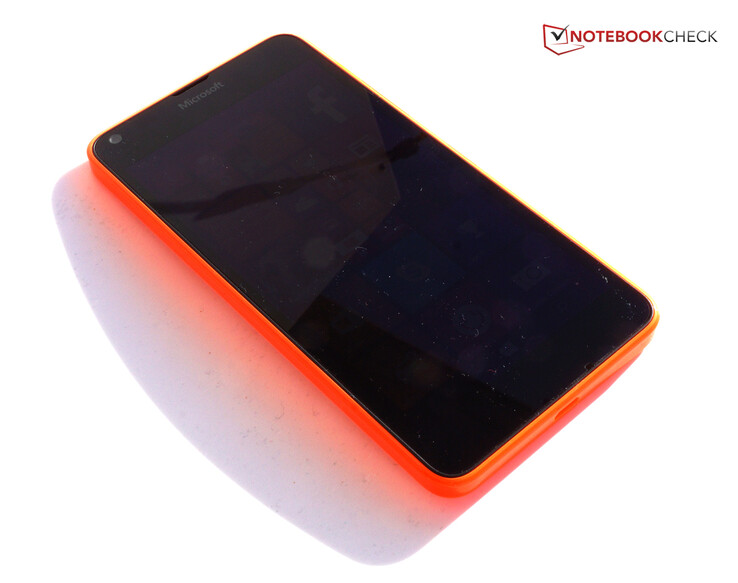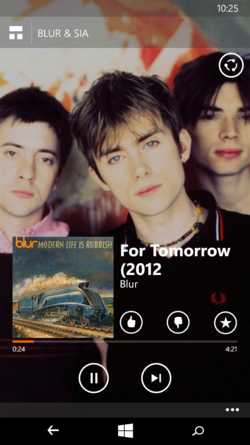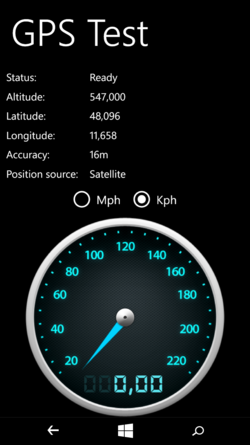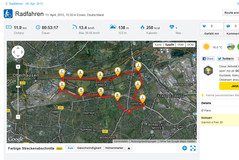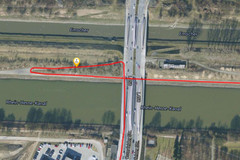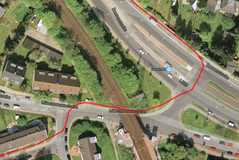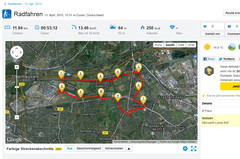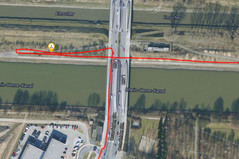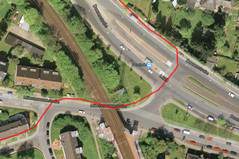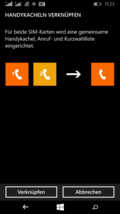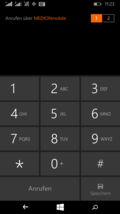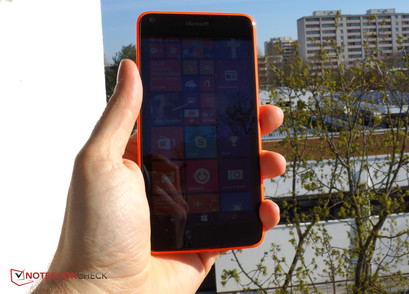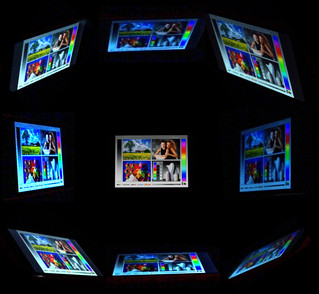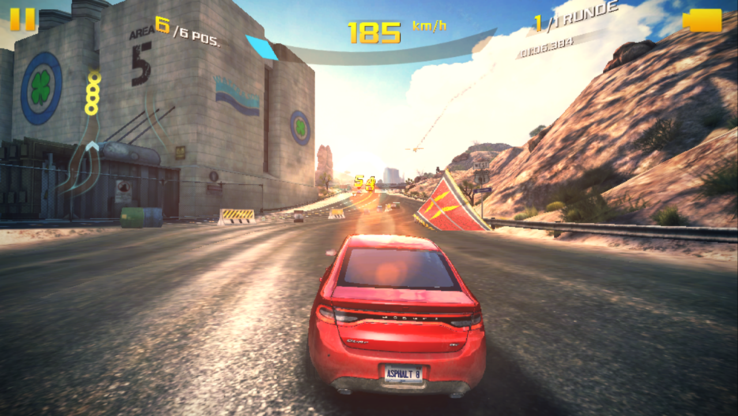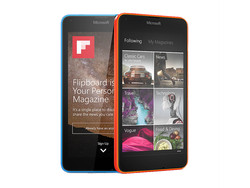Microsoft Lumia 640 Smartphone Review
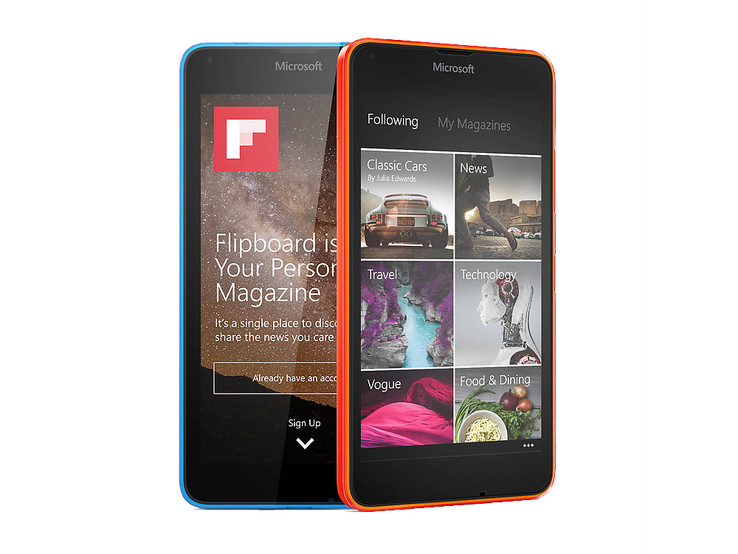
For the original German review, see here.
The Lumia 640 is the most affordable middle-class smartphone from Microsoft. Two versions are available: the lower-priced version has dual SIM slots, but only supports UTMS networks. The more expensive model handles 4G, but can only take a single SIM card. At the time of writing, the price difference online is about 20-30 Euro (~$22-33). Our review smartphone is the dual-SIM variant dressed in a color typical for Lumia phones: neon orange.
The predecessor Nokia Lumia 630 is still available as well and quite a bit cheaper. Slowly but surely, other manufacturers in the western hemisphere are introducing Windows phones as well: Trekstor's WinPhone 4.7 HD is a respectable start, for example. Apart from that, most competing phones in this price range are Android-based like the Samsung Galaxy Grand Prime, the Wiko Ridge 4G, or theTest Wiko Ridge 4G Smartphone Motorola Moto G2.
Case
In a fashion typical for Lumia phones, the 640 is available in rather bold colors with orange as the most vivid and cyan blue as a slightly more muted option. Black and white are for users who prefer a more conservative design. The covers feature a slight two-tone design just like before, but the scheme is more reserved in nature compared to the Lumia 620. As before, the cover is quite easy to remove and gives access to the two SIM slots and the battery. Since the cover encompasses most of the case, swapping it out allows the user to update the look of his or her smartphone. Most will be familiar with this feature, as the previous owner Nokia has offered this option for their phones for decades.
The design is simple, but looks upscale and classy just because of it. Pressing on the display does lead to distortions and audible creaks as well. Another characteristic impacting the positive impression is the fact that the cover and the body move against each other when torsional forces are applied. Most likely that's the price to pay for the enormous versatility offered by the removable cover.
At 145 g, the Lumia 640 is right about average as far as weight is concerned: not quite as heavy as Samsung's Galaxy Grand Prime (156 g), but also not as feather-light as the Trekstor WinPhone 4.7 HD (97 g). The smartphone is 8.8 mm high, which is a bit thicker than the other smartphones mentioned.
Connectivity
Compared to the predecessor Nokia Lumia 630, Microsoft's new offering has been improved in a few areas: the smartphone now contains 1024 MByte of RAM, a 720p display and 8 GByte of storage. The latter can be expanded by up to 128 GB using a MicroSD card. The Lumia 640 is equipped similarly to its competitors, although the Wiko Ridge 4 G features double the amount of RAM and storage. The only other phone to offer dual SIM card slots is the Motorola Moto G2. An FM Radio is integrated as well.
Software
Although Windows Phone 8.1 will be superseded by Windows 10 shortly, the current version of the mobile OS offers a clean interface and quite a few features. The Lumia 640 happens to be the first smartphone to ship with Windows Phone 8.1 Update 2 (GDR2), which brings along a few changes. Lumia Smartphone offers a multitude of additional options and various preinstalled apps enable functions that other Windows phones simply lack.
The feature "Glance Screen" shows the time and notification symbols even when the she screen is off, so the user doesn't have to turn on the smartphone to check the clock, for example.
Starting with screens 5 inches and up, the software automatically displays 6 columns of tiles on the home screen, which leads to small icons and a display that is somewhat crowded with differently colored tiles and flashing Live Tiles. Windows phones with smaller displays allow for adjusting the number of columns, but in this case, individual tiles have to be selected manually to magnify them. We would like to see a more automated adjustment process here or just simply a less crowded start screen in the first place.
As common for Lumia phones, many additional apps are included free of charge: MixRadio streams music for free - including not only artists currently topping the charts, but also classic bands like "Abba" or Indie bands like "Arcade Fire". There's also an enhanced photo app, free navigation software, and the fitness application Fibit. A few add-based applications are part of the package as well, but they are - at least compared to Android - quite easy to uninstall.
At the time of writing, Microsoft also includes one year of Office 365 and a photoplus-subscription for 3 months.
Communication & GPS
Only the LTE version of the Lumia 640 has NFC on board, but at least the new model can connect to a larger number of networks than the predecessor: the review smartphone supports four GMS and four UMTS networks total. The maximum transfer speed is 42.2 MBit/s for downloads and 5.76 MBit/s for uploads. The Lumia 640 LTE also supports 4G.
To connect to wireless networks the Lumia 640 only supports the 2.4 GHz band and the standards 802.11 b/g/n. The reception quality is modest: 10 meters from the router and through three walls the signal quality dropped to 1/4, although pages still load comparatively quick. Another 2 meters and through another wall, web browsing is significantly slower.
The smartphone supports GPS, Glonass, and BeiDou. Indoors, we were unable to establish a GPS lock and the approximate position was established via WLAN. Outside we had a fairly quick lock and an accuracy of about 16 m.
To get a better idea of localization abilities, we took the Lumia 640 along with the professional Garmin eTrex 30 on a bike ride. The smartphone did pretty well and recorded a difference of only 40 meters for the length of the course. The Lumia 640 does seem to have some issues with altitude and our test ride showed only 50 % of the altitude gain the eTrex 30 had recorded. On more difficult trails the Lumia 640 is not quite as accurate as the eTrex 30, although the results are still good.
Telephone & Voice Quality
The Microsoft Lumia 640 supports two micro-SIM cards simultaneously. The software implementation of this functionality features one tile each for phone and messages per SIM card for a total of four tiles. If that should be too confusing, there's also an option to have phone and messages consolidated to one tile. In that case, a little switch appears on the top right which allows the user to change from one to the other SIM card.
The phone application features a clear layout and has quick keys for the mailbox, the dialpad, contacts, and dialed and received calls. Too bad that it's not possible to show contact details - the only option is to call them.
The transmission sound quality is good and our conversation partner found it to be very acceptable as well. With the phone held against our ear, we were able to understand the other user easily, although there's a bit of distortion and also a certain level of boominess at the maximum volume level. The microphone on the other hand did a good job transmitting our voice clearly and without distortions. Hands-free calls are a cinch thanks to the loud speaker and good microphone.
Cameras & Multimedia
The direct predecessor didn't have a front camera at all, which was kind of surprising given how popular selfies are nowadays. The Lumia 640 features one, although the resolution of just 1280 x 720 pixels makes that camera more of an emergency solution. Photo confirm this impression: details are lacking, washed out, and blurred to boot.
The rear-facing camera has been upgraded and now features an 8 MP sensor, which means the Lumia at least compares with the competitors on paper. Unfortunately, we aren't that impressed with the picture quality itself, since colors seem a bit unnatural, transition areas are pixelated, and details are often lacking. The phone shines in low ambient brightness conditions and the photos we took remained pretty sharp with no color noise whatsoever.
The video quality is very decent with a speedy autofocus and good colors and brightness.
Accessories
Microsoft doesn't include a headset or a USB cable. The power adapter features a built-in cable. The most important optional equipment consists of the swappable covers, which cost 16 Euro (~$18) online and are available in orange, cyan, black, and white.
Warranty
In Germany, Microsoft covers their smartphone for a period of 24 months.
Input Devices & Operation
The keyboard is standard Windows Phone 8.1 fare and Microsoft doesn't allow the install of alternative keyboards at this time. The keys are narrow but quite high and we continuously marveled at how easy it is to type. The keyboard is highly accurate even on phones with a smaller display than the Lumia 640. Our review smartphone is of course easier to operate thanks to the larger keys.
They keyboard can be adjusted in numerous ways: to input words, the user can also optionally slide the finger from key to key, new words can be saved in the dictionary and the layout can be modified if so desired. Dictation is supported as well.
The touchscreen is highly precise even in the corners. Only the more expensive Lumia models ship with a glove-friendly touchscreen, however.
Display
The Lumia 640 features a 5-inch IPS display which gets very bright: we measured an average of 429.1 cd/m² - only the Wiko Ridge 4G is brighter still. The brightness distribution is very even at 95 %, so differences are not visible even when looking at larger, uniformly colored areas.
| |||||||||||||||||||||||||
Brightness Distribution: 95 %
Center on Battery: 433 cd/m²
Contrast: 833:1 (Black: 0.52 cd/m²)
ΔE ColorChecker Calman: 3.42 | ∀{0.5-29.43 Ø4.78}
ΔE Greyscale Calman: 3.03 | ∀{0.09-98 Ø5}
Gamma: 2.16
CCT: 7081 K
| Microsoft Lumia 640 Adreno 305, 400 MSM8226, 8 GB eMMC Flash | Samsung Galaxy Grand Prime Adreno 306, 410 MSM8916, 8 GB eMMC Flash | Trekstor WinPhone 4.7 HD Adreno 302, 200 MSM8212, 8 GB eMMC Flash | Wiko Ridge 4G Adreno 306, 410 MSM8916, 16 GB iNAND Flash | Motorola Moto G 2. Gen XT1068 Adreno 305, 400 MSM8226, 8 GB SSD | Nokia Lumia 630 Adreno 305, 400 MSM8226, 8 GB eMMC Flash | |
|---|---|---|---|---|---|---|
| Screen | -40% | -46% | -50% | -10% | -45% | |
| Brightness middle (cd/m²) | 433 | 426 -2% | 418 -3% | 459 6% | 349 -19% | 355 -18% |
| Brightness (cd/m²) | 429 | 415 -3% | 420 -2% | 434 1% | 348 -19% | 350 -18% |
| Brightness Distribution (%) | 95 | 90 -5% | 89 -6% | 90 -5% | 96 1% | 91 -4% |
| Black Level * (cd/m²) | 0.52 | 0.83 -60% | 0.93 -79% | 0.35 33% | 0.4 23% | 0.73 -40% |
| Contrast (:1) | 833 | 513 -38% | 449 -46% | 1311 57% | 873 5% | 486 -42% |
| Colorchecker dE 2000 * | 3.42 | 5.98 -75% | 6 -75% | 9.69 -183% | 3.74 -9% | 7.19 -110% |
| Greyscale dE 2000 * | 3.03 | 6.03 -99% | 6.36 -110% | 10.8 -256% | 4.52 -49% | 5.63 -86% |
| Gamma | 2.16 102% | 2.48 89% | 2.46 89% | 1.82 121% | 2.63 84% | 1.97 112% |
| CCT | 7081 92% | 7983 81% | 7974 82% | 9063 72% | 7336 89% | 6293 103% |
* ... smaller is better
Both the black value and the contrast are very good as well, although the Wiko Ridge 4G outperforms the Lumia once again. Still, a contrast ratio of 833:1 and a black value of 0.52 cd/m² constitute a good result.
For a more in-depth analysis of the color reproduction we use the CalMan software and a spectrophotometer. Although the display doesn't suffer from a bluish hue, the colors appear slightly more purple than they do in the reference space sRGB. Both graylevels and colors are quite accurate overall and compared to the other smartphones mentioned in this review, the Lumia 640 shows the lowest deviation from the ideal.
Thanks to the bright display, the Lumia 640 does pretty well outdoors. The reflective panel is of course less than ideal in direct sunlight, but we had no issues using the review smartphone in brighter environments.
Peformance
The Lumia 640 is equipped with a Qualcomm Snapdragon 400 MSM8226 - the same SoC used for the predecessor Lumia 630. The results of the benchmark tests are therefore comparable and indeed very similar.
The SoC features four cores and runs at a maximum of 1.2 GHz, which is good enough for smooth performance overall. Windows Phone 8.1 is a pretty frugal OS in the first place, however. Some applications and tasks can push the SoC to its limits. The Trekstor WinPhone 4.7 HD is slower by about 15 % as far as the processor performance is concerned; the most powerful smartphone in our comparison is the Wiko Ridge 4G.
The Adreno 305 GPU is better suited for simple tasks and games and the benchmark scores show the review smartphone trailing the Wiko Ridge 4G and the Motorola Moto G2 by a fair margin.
Internet Explorer 11 is generally not a speed demon during web surfing sessions, so Android phones usually do much better in this category. The Lumia 640 clearly outperforms the Trekstor WinPhone 4.7 HD, however.
| Linpack Android / IOS | |
| Single Thread (sort by value) | |
| Microsoft Lumia 640 | |
| Trekstor WinPhone 4.7 HD | |
| Wiko Ridge 4G | |
| Motorola Moto G 2. Gen XT1068 | |
| Multi Thread (sort by value) | |
| Microsoft Lumia 640 | |
| Trekstor WinPhone 4.7 HD | |
| Wiko Ridge 4G | |
| Motorola Moto G 2. Gen XT1068 | |
| GFXBench (DX / GLBenchmark) 2.7 | |
| T-Rex Onscreen (sort by value) | |
| Microsoft Lumia 640 | |
| Wiko Ridge 4G | |
| Motorola Moto G 2. Gen XT1068 | |
| 1920x1080 T-Rex Offscreen (sort by value) | |
| Microsoft Lumia 640 | |
| Wiko Ridge 4G | |
| Motorola Moto G 2. Gen XT1068 | |
| Sunspider - 1.0 Total Score (sort by value) | |
| Microsoft Lumia 640 | |
| Samsung Galaxy Grand Prime | |
| Trekstor WinPhone 4.7 HD | |
| Wiko Ridge 4G | |
| Motorola Moto G 2. Gen XT1068 | |
| Nokia Lumia 630 | |
| Octane V2 - Total Score (sort by value) | |
| Microsoft Lumia 640 | |
| Samsung Galaxy Grand Prime | |
| Trekstor WinPhone 4.7 HD | |
| Wiko Ridge 4G | |
| Motorola Moto G 2. Gen XT1068 | |
| Nokia Lumia 630 | |
| Mozilla Kraken 1.1 - Total (sort by value) | |
| Microsoft Lumia 640 | |
| Samsung Galaxy Grand Prime | |
| Trekstor WinPhone 4.7 HD | |
| Wiko Ridge 4G | |
| Nokia Lumia 630 | |
| Google V8 Ver. 7 - Google V8 Ver. 7 Score (sort by value) | |
| Microsoft Lumia 640 | |
| Trekstor WinPhone 4.7 HD | |
* ... smaller is better
Gaming Performance
The fairly resource-intensive 3D-Racing-Game "Asphalt 8: Airborne" isn't playable without visible stuttering. The reason is probably the fairly high display resolution in combination with the weaker graphics unit. The low frame rate also seemed to result in a slight input lag when issuing commands and a few times we crashed as a result. 1 GB of RAM is just enough to install the games from the app store; when browsing games with the predecessor, certain games didn't even show up because the RAM wasn't sufficient.
Emissions
Temperature
We recorded a maximum temperature of 40.7 degrees C under load, which is quite noticeable already. Even so, the phone can still be hand-held without any issues. The predecessor got warmer still, so Microsoft was able to improve the phone in this area. We appreciate the fact that the Lumia 640 doesn't seem to get warm at all during idle.
(±) The maximum temperature on the upper side is 40.7 °C / 105 F, compared to the average of 35.2 °C / 95 F, ranging from 21.9 to 247 °C for the class Smartphone.
(+) The bottom heats up to a maximum of 39 °C / 102 F, compared to the average of 34 °C / 93 F
(+) In idle usage, the average temperature for the upper side is 26.1 °C / 79 F, compared to the device average of 32.9 °C / 91 F.
Speakers
The single speaker is located on the back, which can lead to muffled sound when the phone is placed on a table. Applying a bit of pressure to the top amplifies this effect. Too bad: the overall sound is powerful and balanced to a fair degree as well. Users who plan to listen to music should probably consider external speakers or headphones, which sound decently no matter if they are connected to the audio jack or Blutetooth.
Energy Management
Power Consumption
Compared to the predecessor Lumia 630, the power consumption of the new phone is substantially higher across the board. Even when compared to competing smartphones, the power draw is pretty high with an average of 2.1 watts and a maximum of 2.5 watts during idle. The maximum of 4.6 watts under load is the second-highest in our comparison; the average power consumption of 3.9 watts is the highest.
| Off / Standby | |
| Idle | |
| Load |
|
Key:
min: | |
Battery Life
Microsoft has equipped their new Lumia phone with a higher-capacity battery. That's not surprising when one considers that the phone has grown in size substantially. The battery now has a capacity of 9.5 Wh and is therefore one of the largest in our comparison. Because of the high overall power consumption, the Lumia 640 only posted average run times, however.
The review phone lasted for 8 hours and 22 minutes during the WLAN test; during mixed use, the Lumia 640 will easily last through the entire day according to our experience. Considering the high battery capacity, the results could've been better though.
| Microsoft Lumia 640 Adreno 305, 400 MSM8226, 8 GB eMMC Flash | Samsung Galaxy Grand Prime Adreno 306, 410 MSM8916, 8 GB eMMC Flash | Trekstor WinPhone 4.7 HD Adreno 302, 200 MSM8212, 8 GB eMMC Flash | Wiko Ridge 4G Adreno 306, 410 MSM8916, 16 GB iNAND Flash | Motorola Moto G 2. Gen XT1068 Adreno 305, 400 MSM8226, 8 GB SSD | Nokia Lumia 630 Adreno 305, 400 MSM8226, 8 GB eMMC Flash | |
|---|---|---|---|---|---|---|
| Battery runtime | -4% | -38% | -13% | 39% | 11% | |
| Reader / Idle (h) | 18 | 16.4 -9% | 13.7 -24% | 19.9 11% | 15.9 -12% | |
| H.264 (h) | 9.1 | 15.7 73% | 12.3 35% | |||
| WiFi v1.3 (h) | 8.4 | 8.5 1% | 5.2 -38% | 8.3 -1% | ||
| Load (h) | 2.8 | 3.7 32% | 3.1 11% | |||
| WiFi (h) | 15.1 | 14.6 |
Pros
Cons
Verdict
More RAM, a front-facing camera, higher resolution - the list of improvements is pretty long when we compare the Lumia 640 to its predecessor. An update was sorely needed to keep the phone competitive and Microsoft delivered. Despite the larger-capacity battery, the battery life hasn't improved much though, since the power consumption has gone up as well.
Many users will appreciate the fact that the battery is removable and that the covers can be replaced, which increases the flexibility and allows for greater individualization. The Lumia 640 comes with a decent GPS module, good voice transmission quality, a lot of software, and a modern OS that isn't very convoluted. Because of the premium software package and the included subscription services, we've added an additional point to the overall test score.
Users who need a high-quality camera are probably not going to be completely satisfied with the Lumia 640: the phone handles low-light conditions very well, but in normal conditions the colors are inaccurate and washed out. The front-facing camera is more of an alibi and not good enough to be truly useful.
The Lumia 640 is a good middle-class smartphone which impresses with a high degree of flexibility and its customization-features.
Microsoft Lumia 640
- 04/27/2015 v4 (old)
Florian Wimmer




